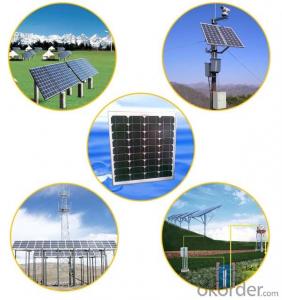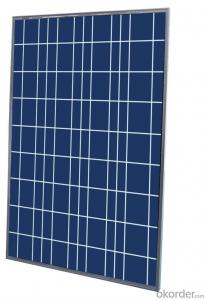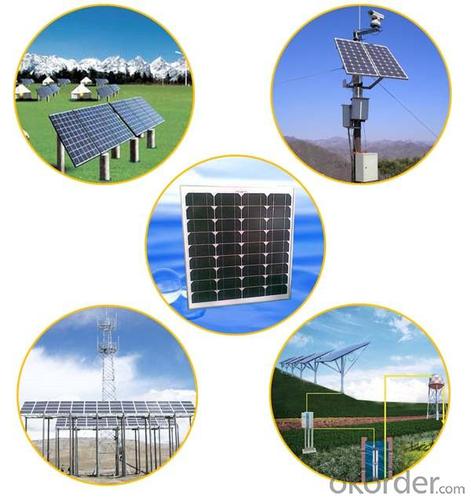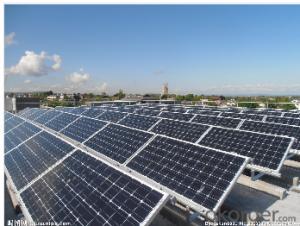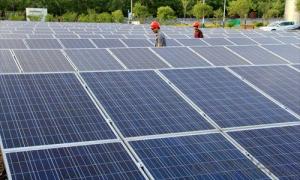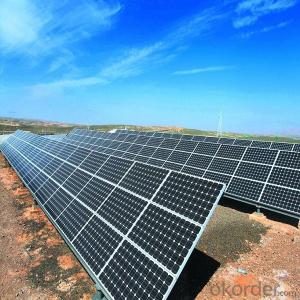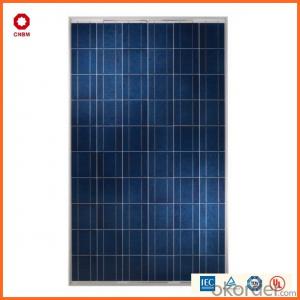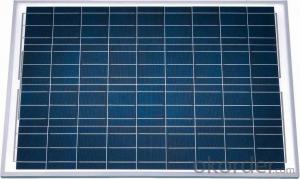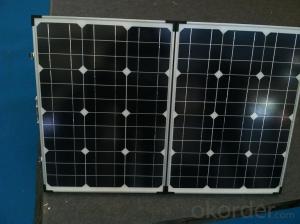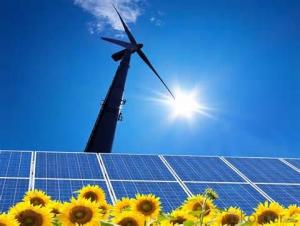150w TUV/CE Approved Poly-Crystalline Solar Panels in New Mexico
- Loading Port:
- Shanghai
- Payment Terms:
- TT OR LC
- Min Order Qty:
- 10000 watt
- Supply Capability:
- 1000000 watt/month
OKorder Service Pledge
OKorder Financial Service
You Might Also Like
Specification
Product Description
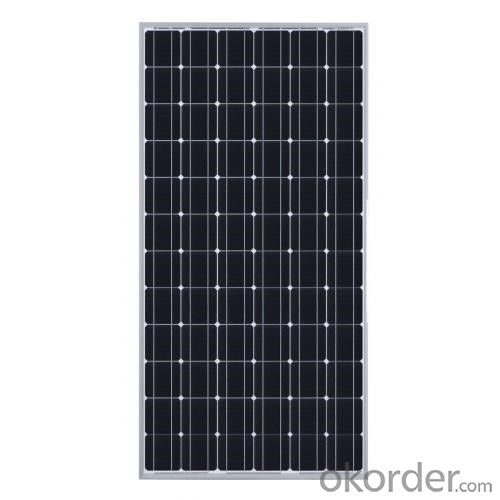
150W TUV/CE Approved Poly-Crystalline Solar Panel
Features:
High conversion efficiency
Low power tolerance of 0~+3%
Low degradation under light exposure
Ability to withstand high wind-pressure, snow load and extreme temperature
Passing IEC 61215 5400Pa mechanical load test
Quality and Safety:
10-year warranty on product materials and processing technology
Power output warranty: 10 years: 90%, 25 years: 80%
ISO 9001: 2008(Quality Management System) certified factory
IEC61215, IEC61730, MCS CEC certified products
TUV, CE conformity
Applications
On-grid residential roof-tops
On-grid commercial/industrial roof-tops
Solar power plants
Off-grid system
Other on-grid applications
Specifications
| Peak Power(Pmax) | 150.00 | |
| Maximum Power Voltage(Vmp) | 18.61 | |
| Maximum Power Current(Imp) | 8.10 | |
| Open Circuit Voltage(Voc) | 22.19 | |
| Short Circuit Current(Isc) | 8.62 | |
| Module Efficiency() | 15.12 | |
| Maximum System Voltage(V) | 1000 | |
| Maximum Series Fuse Rating(A) | 15 | |
| Power Tolerance | 0~+3 | |
| Pmax Temperature Coefficients(W/ºC) | -0.450 | |
| Voc Temperature Coefficients(V/ºC) | -0.350 | |
| Isc Temperature Coefficients(A/ºC) | +0.040 | |
| NOCT Nominal Operating Cell Temperature(ºC) | 47±2 | |
| Operating and Storage Temperature(ºC) | -40~+85 | |
| Standard Test Condition(STC) | 1.000W/;AM 1.5;25+/-2ºC | |
Mechanical characteristics & Packing
| Cell Type | Poly-crystalline 156×156mm |
| No. of Cells | 36(4×9) |
| Dimensions | 1485×668×35mm |
| Weight | 11.60kgs |
| Front Glass | 3.2mm high transmission,low iron,tempered glass |
| Frame | Anodized Aluminium Alloy |
| Junction box | IP65 Rated |
| Output cables | 4.0mm² Length 90mm, MC4 connector |
| 1x20' | 14pallets/354pcs |
| 1x40'HQ | 30pallets/890pcs |
- Q: Can solar panels be installed on a south-facing wall?
- Yes, solar panels can be installed on a south-facing wall. In fact, a south-facing wall is often the most ideal location for solar panel installation as it receives the most direct sunlight throughout the day, maximizing energy production.
- Q: my dad met a guy representive for a solar panel company at a swapmeet Scam?
- Hard to say. Solar panels are becoming more common these days. May want to ask if the vendor is licensed and bonded contractor (if he's doing installation as well as panel sales). Find out the name of the equipment that this guy is selling (panels and other hardware) and do a search. For that matter, get the guys name and do a search on it to see he pops up elsewhere.
- Q: I need to build a battery array to use with my solar panels I just bought. I want to be able to store enough energy to be draw from it at night, possibly around the clock. Is there a down side to using the deep cycle battery I bought from autozone and 6 or 7 more just like it, or do I need to get some other battery?
- There are batteries particularly made for solar, such as the Trojan T05-RE . I think the RE stands for renewable energy. A deep cycle battery should work all right, although not quite as well. What you want to do is try out your setup first, with just one battery, and the panels provided. If this is one of those 45 watt kits, you may be surprised at how little energy you actually get from the panels. Increasing the number of batteries won't help, either - that's like getting a larger water tank, when you only have a trickle to fill it. If your goal is really to save money, the most cost-effective solar is the grid-tied type, with no batteries at all. That's what we have, and I've never regretted it.
- Q: Can solar panels be installed on south-facing windows?
- Yes, solar panels can be installed on south-facing windows as long as the windows receive sufficient sunlight throughout the day.
- Q: does it mean that it can get that much in a day? Or like, in an hour?
- Wattage okorder
- Q: all i want to do is provide enough electricity for 2 fluorescent bulbs i was looking at some 80 watt panels how many of those would i need and what else do i need for storing the electricity for use at nite? and how much would it all cost?
- The solar panels are made in China because there are fewer environmental regulations and cheap coal power. It takes a lot of energy to melt silicon and there are toxic waste products. It would be three to five times more expensive to make the panels in the US ( three times is just for reprocessing the toxic wastes ). Solar cell made in China are about $2 a watt, perhaps as low as $ a watt but in truth the claims for $ a watt or less solar panels as in thin film solar panels have much lower efficiency and require perhaps ten times more surface area.
- Q: Tell me complete installation I have one 50Ah battery two 80 watts solar panels about 30 meter DC wire i charge ontroller and 000watt inverter. How i hook two solar panels to charge controller to battery then inverter?
- Wires from panels go to controller input terminals. Controller DC battery terminals to battery so that the controller will protect batteries and split power as required by demand to the inverter. Output DC on controller to inverter. Output AC or outlets on the inverter to AC appliances. One thousand watts is not very much capacity. It will keep your computer running and a lamp to read by. It won't run major appliances. A hair dryer is typically 500 watts and could not be run by this system.
- Q: thinking of getting a portable solar panel laptop charger...may be a stupid question but may be a very intelligent one as well ;)
- As long as the solar panel has access to light it will operate. If you can keep it in the sunlight it will work a lot better than off the internal lights on the plane. Depending on the plane/lighting/your position, there might not be enough ambient light available for the solar panels to run your laptop.
- Q: Mitsubishi Solar Panels For Home Installation: How Much Do The Panels Cost?
- Panels will cost in the range of 300-600 dollars for about 00 watts on average ( enough for one large lightbulb to run a few hours a day). The rest of the system needed will cost $2500-$4000. That is for the equipment. Cost for Installation?? Figure about 0 year life on equipment. It will probably never pay back investment, but will cut power usage. You can reduce power usage much more cost effectively buy simply conserving (Hot water temp. down, CFE bulbs, Better insulation, Better windows, Heat/Air a little colder/hotter, Attic ventilation, Geo Thermal heating/colling system). All of these measures will pay back sooner and save power usage. Solar will never pay back without major subsidies from the taxpayers. Particularly if in an area that has many cloudy days. Check it out. The calculations are basic and the facts are available if you really want them. Don't believe any salesmen or Environmentalists. They don't want you to know the facts.
- Q: Can solar panels be installed on a carport or parking lot?
- Yes, solar panels can be installed on a carport or parking lot. In fact, carport solar installations are becoming increasingly popular as they serve a dual purpose of providing shade for vehicles while also generating clean and renewable energy. Similarly, solar panels can be mounted on parking lot structures, maximizing the use of available space and contributing to reduced dependence on fossil fuels.
Send your message to us
150w TUV/CE Approved Poly-Crystalline Solar Panels in New Mexico
- Loading Port:
- Shanghai
- Payment Terms:
- TT OR LC
- Min Order Qty:
- 10000 watt
- Supply Capability:
- 1000000 watt/month
OKorder Service Pledge
OKorder Financial Service
Similar products
Hot products
Hot Searches
